-
Q. Discuss the primary and secondary factors that contribute to the formation of ocean currents. How do these factors interact and influence the characteristics of ocean currents, and what are the global implications of these interactions? (250 Words)
23 Oct, 2023 GS Paper 1 GeographyApproach
- Begin with a concise introduction that provides an overview of what ocean currents are and their significance in the Earth's systems.
- Discuss the primary and secondary factors responsible for ocean current formation.
- Discuss how these factors interact and influence the characteristics of ocean currents. Highlight the far-reaching consequences of ocean currents on a global scale.
- You can conclude by summarizing the key points and emphasize the importance of understanding ocean currents and their multifaceted influences.
Introduction
Ocean currents are the constant, directional flow of seawater, shaped by factors like wind, water density, tides, Earth's rotation, and ocean basin shapes. They create surface, deep-water, geostrophic, and tidal currents, impacting climate, ecology, and economies worldwide.
Body
Some of the main factors that affect ocean currents are:
Primary Factors:
- Wind: Wind is a primary driving force for ocean currents. The friction between the wind and the ocean's surface generates momentum, pushing water in the direction of the prevailing winds.
- Temperature and Density: Differences in temperature and salinity (salt content) lead to variations in water density. Colder, denser water sinks, while warmer, less dense water rises. These density differences, known as thermohaline circulation, drive deep ocean currents. The sinking of cold, dense water in polar regions and the upwelling of warmer water in equatorial areas are crucial components of this process.
Secondary Factors:
- Coriolis Effect: The Coriolis effect influences the direction of ocean currents in each hemisphere. Coriolis effect causes ocean currents to veer to the right in the Northern Hemisphere and to the left in the Southern Hemisphere. It ensures that water masses move in a more circular pattern, creating the major gyres (circular currents) in the world's oceans, such as the North Atlantic Gyre and the South Pacific Gyre.

- Continental Boundaries: The shape and arrangement of continents play a significant role in directing and modifying ocean currents. For instance, when ocean currents encounter a continent, they are deflected, which can result in the creation of coastal currents or eddies.
- Tides: Tidal forces, primarily caused by the gravitational pull of the Moon and the Sun, lead to the rise and fall of sea levels. These tidal changes can create tidal currents in coastal areas, affecting local ocean circulation patterns.
Interactions and Influence on Characteristics:
- These factors interact in complex ways. Wind-driven surface currents, for example, can transport warm or cold water to different regions, affecting local climates.
- The Coriolis effect influences the direction and speed of these currents, while temperature and density differences create vertical movement, influencing the deeper, slower currents.
- Continental boundaries and tides can further modify these patterns.
Global Implications:
- Climate: Ocean currents transfer heat and moisture, impacting regional climate. Warm currents increase evaporation and precipitation, while cold currents reduce them. They also influence weather patterns and events like El Niño-Southern Oscillation.
- Ecology: Ocean currents transport nutrients and organisms, influencing marine ecosystems. Upwelling currents support biodiversity by bringing nutrient-rich water to the surface. Downwelling currents maintain oxygen levels. They aid in the dispersal of marine life, enhancing connectivity and diversity.
- Economy: Ocean currents provide resources and opportunities. They support fisheries, offer renewable energy sources, and aid maritime transportation by reducing travel time and fuel consumption.
Conclusion
The formation of ocean currents is a complex interplay of primary and secondary factors, with far-reaching implications for climate, ecosystems, and weather patterns. Understanding these dynamics is crucial for predicting and adapting to the consequences of ongoing climate change and other environmental challenges.
To get PDF version, Please click on "Print PDF" button.
Print PDF




